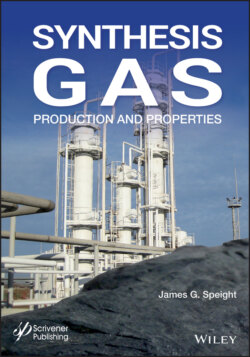Читать книгу Synthesis Gas - James Speight G., James G. Speight - Страница 64
2.6.3 Tar
ОглавлениеAnother key contribution to efficient gasifier operation is the need for a tar reformer. Tar reforming occurs when water vapor in the incoming synthesis gas is heated to a sufficient temperature to cause steam reforming in the gas conditioning reactor, converting condensable hydrocarbon derivatives (tars) to non-condensable lower molecular weight molecules. The residence time in the conditioning reactor is sufficient to also allow a water gas shift reaction to occur and generate increased amounts of hydrogen in the synthesis gas.
Thus, tar reforming technologies – which can be thermally driven and/or catalytically driven – are utilized to break down or decompose tars and high-boiling hydrocarbon products into hydrogen and carbon monoxide. This reaction increases the hydrogen-to-carbon monoxide (H2/CO) ratio of the synthesis gas and reduces or eliminates tar condensation in downstream process equipment. Thermal tar reformer designs are typically fluid-bed or fixed-bed type. Catalytic tar reformers are filled with heated loose catalyst material or catalyst block material and can be fixed or fluid bed designs.
Typically, the tar reformer is a refractory lined steel vessel equipped with catalyst blocks, which may contain a noble metal or a nickel-enhanced material. Synthesis gas is routed to the top of the vessel and flows down through the catalyst blocks. Oxygen and steam are added to the tar reformer at several locations along the flow path to enhance the synthesis gas composition and achieve optimum performance in the reformer. The tar reformer utilizes a catalyst to decompose tars and high boiling hydrocarbon derivatives into hydrogen and carbon monoxide. Without this decomposition the tars and high boiling hydrocarbon derivatives in the synthesis gas will condense as the synthesis gas is cooled in the downstream process equipment. In addition, the tar reformer increases the hydrogen/carbon monoxide ratio for optimal conversion. The synthesis gas is routed from the tar reformer to downstream heat recovery and gas cleanup unit operations.
